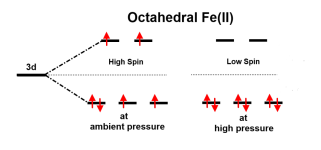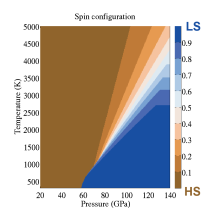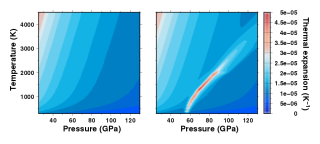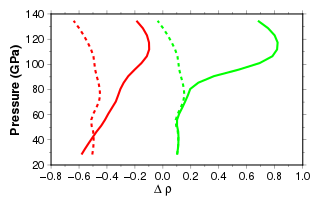





 |
 |
 |
| [PDF (17 kB)] [PNG (40 kB)] |
[PNG (47 kB)] | [PNG (24 kB)] |
| Schematic diagrams of electronic spin configuration of Fe2+ in the octahedral site of ferropericlase. On the left, the high spin state stable at ambient conditions, and on the right the low spin state stable at high pressure. Red arrows are electrons. | Simplified view of mantle convection composed of a large plume and a large sinking slab. At top, the potential temperature and at bottom the corresponding spin state configuration. The spin state transition occurs at greater depths within the plume at at shallower depths within the slab, which tends to enhance upwelling and downwelling velocities. | Spin state configuration as a function of temperature and pressure obtained with the theoretical model presented in Vilella et al. (2015). Blue is low spin state, brown is high spin state. Note the sharp transition at low temperature and the continuous transition over a large range of pressure at higher temperatures. |
 |
 |
|
| [PDF (16 MB)] [PNG (102 kB)] |
[PDF (30 kB)] [PNG (22 kB)] |
|
| Coefficient of thermal expansion as a function of temperature and pressure obtained for a pyrolitic composition. On the left, without the spin state transition, on the right with the spin state transition. Note the strong increase of the coefficient of thermal expansion associated to the spin state transition. For more details on the theoretical model and on the input parameters, please see Vilella et al. (2015). | Relative density difference compared to PREM (%) as a function of pressure for each of the models presented in Vilella et al. (2015). Green lines for a pyrolitic composition without aluminium, red lines for a pyrolitic composition with aluminium. Dashed lines are the reference models without the spin state transition. |